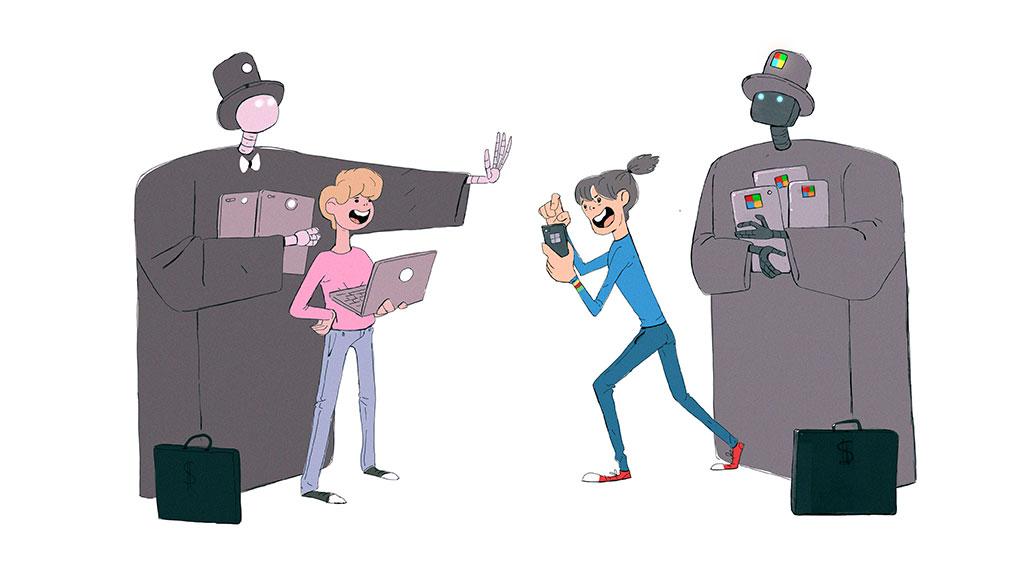With new and innovative technology released every season, the competition to attract and maintain loyal consumers is intense. Whether or not one company has more advanced technology or a just-as-reliable and affordable option, big names, such as Apple, need to ensure that consumers go to them for the latest and greatest gear.
In order for companies to get customers to purchase their products, they not only need loyal customers, but also advocates — customers who will recommend their brand’s products to consumers buying from competition.
This is where brand loyalty comes into play. Companies want their current customers’ perception and understanding of the brand to guarantee that they not only keep buying, but also influence others to buy.
Breaking Down Brand Loyalty
Professor Emi Moriuchi teaches marketing courses in Saunders College of Business and studies how brands market to their audiences.
“To me, brand loyalty … is about you being a repeat customer [and] not only a repeat customer, but an endorser – you spread the opinion that you have to other people,” Moriuchi said.
Moriuchi also described brand loyalty as knowing that even if another product has more advanced technology or is a cheaper option, a customer would still choose ‘their brand’ as opposed to looking at other options. Brand loyalty is something that tech giants want in their clientele.
“Once you are in [a brand], it is hard to shift — like a bank account,” Moriuchi explained.
When a customer is devoted to a company’s brand, it can be hard for them to switch as they may feel intimidated by searching for a different company.
“Once you are in [a brand], it is hard to shift — like a bank account.”
Brand loyalty in this sense can be both active and passive. On one hand, the customer will go out and be an influencer for their brand, whereas passive brand loyalty can be seen in the hesitation to change companies. This can be due to either the new brand being perceived as too complex or the switch being too daunting of a task for the consumer.
“Think of search engines. Most people use Google as their primary source,” Moriuchi said.
It may be weird to consider having brand loyalty to a search engine; however, when you think about when you need a question answered, you probably Google it. Moriuchi also discussed brand loyalty that is passed down through a family or the people that you associate with.
“If your whole family has iPhones, you will probably get an iPhone because you are familiar with it,” Moriuchi said.
This sort of implicit brand loyalty can also be seen in cars, grocery chains, phone service and so many other industries.
Defining the Brand
Before a company can say that they have brand-loyal customers, they need to first establish a consistent brand, according to Entrepreneur magazine. A company must know what sets it apart from the competition long before it decides to enter the ring.
Liz Vosburgh, a fourth year Marketing major, has worked in the marketing world and understands how companies create and uphold their brand.
“Now it is all about experience the customer has,” Vosburgh said.
Customers will not judge a company based solely on what their store looks like. They take everything into account from the way the employees act to the way the brand portrays itself in the social space.
Speaking to the success of Apple, Vosburgh said that it’s the consistency of the brand that people can recognize and relate to. With Apple’s commercials and advertisements all following the same guidelines and values, the company can ensure that the brand appears the same across all platforms.
“Companies have brand style guides now,” Moriuchi said.
These documents cover everything from what the logo needs to look like to what words can and cannot be used. Having style guides in place helps to make sure that the company is conveying the same message, no matter the media.
Marketing Shifts
As social media became more and more accepted into society, the marketing world had to shift and companies had to learn to adapt to the changing platforms.
“Social media changed marketing and branding completely,” Vosburgh said. “Each platform has a different audience and companies need to understand what each one is used for and what audience they are reaching.”
“Social media changed marketing and branding completely.”
Marketing has come a long way from traditional advertising, such as the production of commercials and radio ads. The rise of social media gave companies and consumers direct lines of contact; the days of waiting on hold with customer service are numbered as more and more companies move to social media.
“When you need help from a company, you don’t call or email them now — you tweet them,” Vosburgh said.
Customers have grown accustomed to social media and have adopted numerous platforms into their daily lives, such as Twitter, Facebook and Instagram. Each of these platforms has a certain audience and way that users interact with each other.
Pushing out ads on Instagram engages customers visually, for example. However, companies establish their voice by answering customers’ questions and managing their grievances on Twitter, Moriuchi said. Wendy’s is a master at catering to its audience; with a savage Twitter and “loving mother” Facebook page, it caters to each platform in order to draw in its audience effectively.
With different platforms, audiences and media to convey their brand, how do tech companies ensure that their marketing techniques are keeping customers loyal? With more technology, of course!
“Social media monitoring tools are huge in marketing. [Companies] need to know if they are effectively communicating and interacting with their specific audience,” Vosburgh said.
Brand loyalty is becoming increasingly crucial to the tech industry. With phones, tablets, software and gadgets becoming more advanced and innovative, companies need to stake their claim on the market. In the end, it all boils down to one question: Apple or Android?







